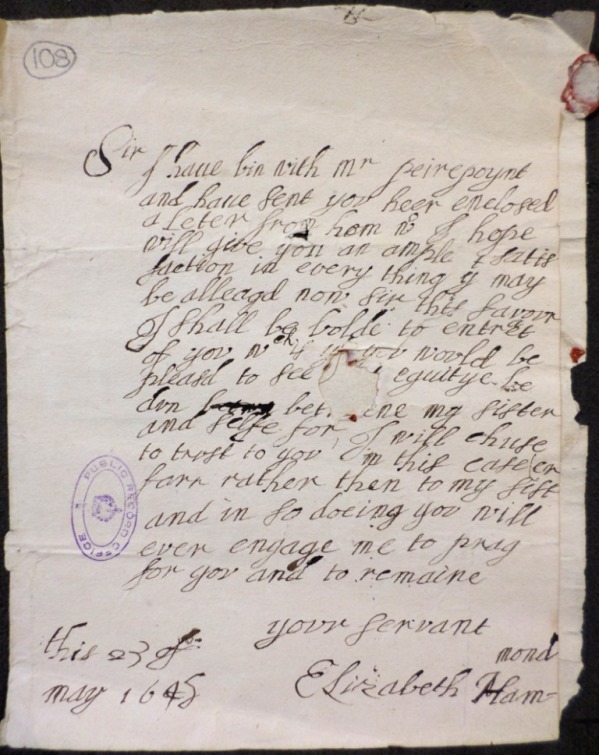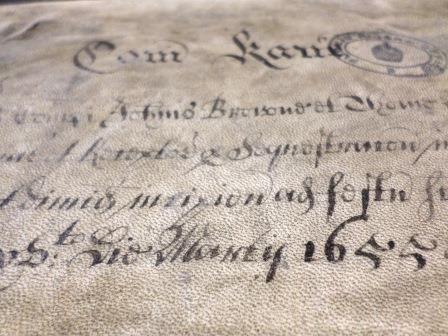The English Civil Wars (1642-1651) were incredibly turbulent, dramatic, and significant. There are hundreds of boxes of records at The National Archives that contain rich stories about the events of the Civil Wars and those people who lived through them.
However, many of the individual documents contained in these boxes are not described in The National Archives’ catalogue, Discovery. As a result it can be difficult to access those stories.
I am a Collaborative Doctoral Partnership PhD researcher here at The National Archives and the University of Leicester. My project, ‘The experience of war widows during the mid-seventeenth century’ – which I’ve blogged about before – has led me to the records that The National Archives holds that relate to the Civil Wars, and in particular the lives of women. During the course of my PhD I have been part of an effort by specialists in the early modern team to make it easier to search and use some of the Civil War records by cataloguing them.
Throughout the period 1642-1660 parliament confiscated the estates of those who had fought for King Charles I, in order to punish them and to make financial gains for themselves. The records of this process are held within the files of the State Papers and they provide a valuable insight into the Civil War experience of those who opposed Parliament. Women whose husbands had fought and died for the King had their lands taken away and, alongside men who had also lost lands, they petitioned central Parliamentary committees in order to regain them. Within these files are documents that tell us what it was like for women who had been accused of siding with ‘the enemy’ to live through this uncertain period.
The records of the County Sequestration Committees (SP 28/205-218) are some of these. This committee was responsible for carrying out Parliament’s order that the estates of Royalists be confiscated. Local agents were charged with collecting the rents from the tenants of Royalist landowners and identifying potential estates to confiscate. The State Papers also hold the records of the central committees that these agents reported to; these are currently accessible via a calendar (The Committee for Compounding with Delinquents, SP 23) and a recently completed cataloguing project (The Committee for Sequestrations, SP 20).
This current cataloguing project, for parts of SP 28, is well underway. Whilst writing descriptions of these documents I have also aimed to discover what I can about how this series can inform our understanding of people’s experience of the Civil Wars. The boxes contain account books with lists of names of 17th century people who either owned confiscated lands or who were tenants on it. These are the names of people from all sectors of society and may provide some clues about the, often hidden, lives of ordinary people. A key priority for the project was to include as much detail relating to people and places on the catalogue. We started with my home county: Kent.
The boxes for Kent are large and contain miscellaneous material. By starting to catalogue these files we have not only improved the accessibility of these records, but have also come across some interesting stories and documents along the way.
A small document, pictured below, immediately grabbed my attention as I went through the files. It stands out as a unique-looking document amidst sheaths of receipts and account books written in the hand of a competent scribe. This is because it appears to have been written by a woman, Elizabeth Hammond, who was writing personally to a member of the Kentish elite asking for his help in regaining her lands. In the letter she wrote: ‘I will chuse to trust you in this case …and in so doeing you will ever engage me to pray for you’ and signed her name. To have a document penned by a woman herself is unusual and it gives some precious extra detail into the lives of those people who can otherwise appear simply as names on an account book page.

Letter written by Elizabeth Hammond (catalogue reference: SP 28/210/108)
As well as this document, I occasionally came across other records that were particularly visually striking. The front cover of one of the committee order books is covered in different scripts and calculations as one scribe, or maybe a few, used the page as a way to test their pen and to help them with their arithmetic. You can also see from this image that the book was bound within an older parchment document that was dated 1638. Pages like this help to demonstrate that there was a working process and a person behind the creation of all documents – and that in this case that person seems to have been a bit of a scribbler!
Contained within this order book there are also some other hints at the ways in which living through the Civil Wars changed the lives of ordinary men and women. The book records all those who the committee members decided were liable to have their lands confiscated by Parliament. One such landowner, Thomas Prowder, lost his lands because he had been accused of ‘giving ill language against the Parliament’. The Parliamentary order for land confiscations was originally meant to only include those who had fought for the King, but details like these show how concerned Parliament’s agents were about disloyalty, and how little one had to do in order to be branded as an enemy.

Front pages of the Kent Sequestration Committee’s Book of Orders (catalogue reference: SP 28/210/13)
These are just a few examples of the interesting stories and striking documents that I encountered as part of this cataloguing project. It is rewarding to encounter records that have not been often used, and to encounter hints of the lives of the people who created the documents as well as those who were the subject of them. Primarily, I hope that these records will help to further our understanding about the Civil Wars and what it may have been like to live through this period in history.
Enhanced item level descriptions for the County Sequestration Committee in Kent, SP 28/210, are now available on Discovery, our catalogue.

Interesting, I looked at SP 210/28/211 and saw :-
“Places Mentioned: Earith [Erith, Greater London]; Orpington [Greater London]; St Mary Cray [Greater London]”. Obviously Erith. Orpington and St Mary Cray were when I last looked not in Greater London but Kent both at the time and today.
I believe David is right, a range of places are in Kent, and, indeed, other home counties. I was distracted by this realisation until I focused more broadly on the message of the article, at which point I was struck by the amazing access to lost women’s voices in SP 28.
Dear David,
I presume you are referring to SP 28/210/11 rather than SP 210/28/211, which does not exist.
Erith, Orpington and St Mary Cray were previously in the county of Kent. The London Government Act of 1963, however, placed them into the London Boroughs of Bexley and Bromley respectively, and as such they are currently considered part of Greater London.
As part of this cataloging project the decision was made to include the current county or region that a place is situated in when this differs from the county for which the sequestration accounts were drawn up, in this case Kent.
Regards,
Dr Laura Tompkins
I am an American with a British (probably English) ancestor who came as indenture
to Virginia, 1691. Sketchy work to follow his trail in England but presume, if English,
his parents were alive, though young, at time of Civil Wars. This new source will be interesting to check through as I try to picture the lives of my ancestors. Thanks.